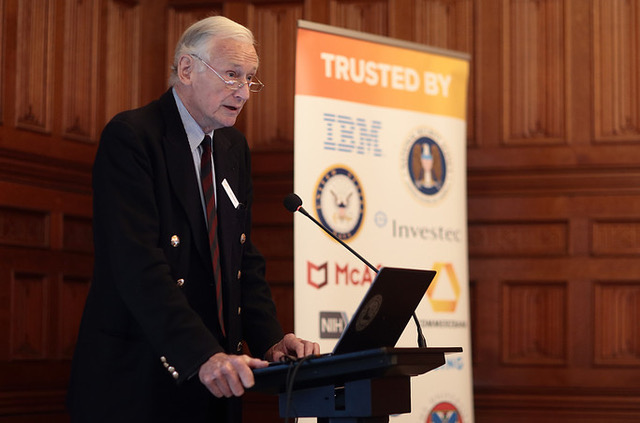We speak to Information Age about how innovation is crucial for businesses looking to remain relevant and stave off disruption.

January 2, 2018
Will innovation lie in the cloud, on the edge or elsewhere?
Industry commentators believe that innovation won’t occur in the cloud, but on the edge. Yet, edge computing is simply just an extension of cloud computing. So, what do they mean? Well, the likelihood is that cloud computing and edge computing will work together. That said, questions still arise about whether the likes of technologies such as facial recognition – which Apple’s recently launched iPhone X is promoting – leads to an increased danger of Big Brother watching over people’s every move. Previously, Apple’s devices used fingerprint recognition, and some Android device equivalents have been designed to use iris recognition. So, science fiction has quickly become science fact. Businesses need to think ahead – particularly as the European Union’s General Data Protection Regulation is due to come into force five months from now. To ensure that retailers, government agencies, emergency services, and other organisations don’t overstep the mark, there is a need for them to consider how technologies such as facial recognition, number plate recognition, body-worn video and connected vehicle sensors can comply with GDPR.
Empowering citizens
Jim McGann, VP Marketing and Business Development at Index Engines, offers his thoughts on the regulations: “GDPR puts personal data back in the hands of the citizens. So, if you have a company doing business in the EU – including from the US – you have to comply.” He adds that GDPR raises a key problem that organisations have with data management. Quite often they find it hard to locate the personal data on their systems or in their paper records. Subsequently, they can’t know whether the data needs to be kept, deleted, modified or rectified. So, with the potentially enormous fines looming over their heads, GDPR will place a new level of responsibility on their shoulders. Nevertheless, he suggests there is a solution: “We provide information management solutions; the ability to apply policies to ensure compliance to data protection regulations. Petabytes of data has been collated, but organisations have no real understanding of what data exists. Index Engines provide the knowledge of this data, by looking at the different data sources to understand what can be purged. Many organisations can free up 30% of their data, and this allows them to manage their data more effectively. Once organisations can manage the content – the data, they can then place the policies around it as most companies know what kinds of files contain personal data.” “Much of this is very sensitive and so not many companies don’t like to talk on the record about this, but we do a lot of work with legal advisory firms to enable organisations with their compliance.,” continues McGann. Index Engines, for example, completed some work with a Fortune 500 electronics manufacturer that found that 40% of its data no longer contained any business value. So, the company decided to purge it from its data centre. “This saves data centre and management costs: They are gaining positive results by cleansing their data, but if you are a public company you can’t delete data randomly as there are regulatory compliance issues”, he points out. In some cases, there is a need to keep files for up to 30 years. “So, you need to ask if the files have business value or any regulatory compliance requirements”*, he advises. For example, if there is no legal reason for keeping the data, then it can be deleted. Some firms are also migrating their data to the cloud to remove their data from their data centre. As part of this process, they are examining whether the data has any business value to make their data migration decisions. Organisations, including data centres, need to consider what lies within their files – no matter whether edge computing or cloud computing are used for data management, backup and storage.
Driverless habits
Let’s return for a moment to the connected and autonomous cars theme. If these vehicles do eventually take off, as many of their proponents expect them to, the drivers are going to become passengers in the same way that rail commuters don’t drive the trains that take them to work each day. So, with the burden of driving removed, they will have more time to entertain themselves in the same way that many rail commuters have done so over the last few years. They will be able to catch up with TV programmes, watch movies while on the go, or listen to music using streaming services. Streaming technologies are fast becoming the way to deliver content to consumers. Such services will add to the surge in data, emanating from connected and autonomous vehicles. The supporters of these automobiles therefore predict – perhaps with their own self-interests in mind – that consumers will agree to move from car ownership to a car-sharing subscription model – similar to the one employed by the likes of Uber and Lyft. These companies offer vehicle on-demand services via a mobile app. This predicted future of personal transport has yet to play out. However, as everyone knows there has been and always will be holes in mobile coverage. So the organisations offering such infotainment services will also need to consider how to deliver smooth buffering for their services in high definition. This, after all, is what everyone has come to expect as consumers in their own homes.
Data acceleration
The reduction in network and data latency can lead to improved customer experiences. However, with the possibility of large congested data transfers to and from the cloud, latency and packet loss can have a considerably negative effect on data throughput. Without machine intelligence solutions such as PORTrockIT, the effects of latency and packet loss can inhibit data and backup performance. This could translate into delays at airports if the facial recognition databases can’t communicate your identity and immigration status quickly, and it could lead to accidents or to technical issues arising in autonomous cars.
Location advertising
In this world social media organisations such as Facebook, Google, Twitter and Snapchat will seek to offer location-based advertising, as someone sitting in a vehicle as a passenger in a driverless vehicle presents a captive audience. However, this also raises privacy and data protection concerns. For example, a recent report that was published by Privacy International criticises car rental firms for “relying on the small print in terms and conditions”, whenever it comes to dealing with data amassed by in-car entertainment systems. These infotainment systems sync up to mobile devices via Bluetooth, storing a range of data such as location logs, as well as information from on-board systems for web browsing, phone calls or streamed music. So, there is a need for players within the autonomous vehicle ecosystem to agree to uphold transparent data-sharing practices – particularly between autonomous vehicle manufacturers, insurance companies and other players within the market.
Answering questions
So, with GDPR on the horizon, will organisations have to seek agreement from individuals to use this data? How are they going to manage collect, manage and use autonomous car data, as well as data created by CCTV cameras and facial recognition systems around the world? Will this be achieved at a small number of cloud locations around the world? These are but some of the questions that require answers. Overall though, transparency is going to be the key word. In many ways this is exactly the problem CERN was facing with the large Hadron Collider. It generates petabytes of raw data for each run, but it does not have the capacity onsite to run full analyses of the data. From the raw data it runs a triage of algorithms to remove all the noise around the real data, before passing the data out to other organisations to do the final and detailed analysis. Organisations are therefore going to need infrastructure that provides a limited level of data computation and data sieving at the edge – perhaps in expanded base stations and then shipped back or from the cloud. This may, for example, involve a hybrid cloud edge infrastructure. Does this solve everything? Not quite. Some fundamental problems still remain, such as the need to think about how to move vast amounts of data around the world – especially if it contains personal encrypted data. More to the point, for innovation to lie anywhere, it’s going to continue to be crucial to consider how to get data to users at the right time, and to plan now how to store the data well into the future.




